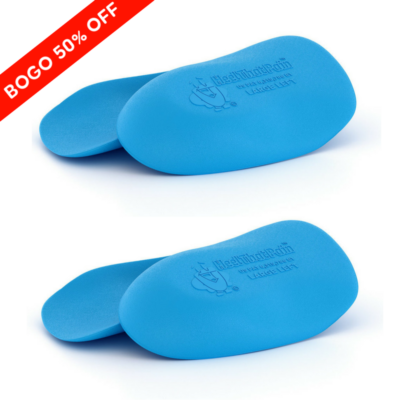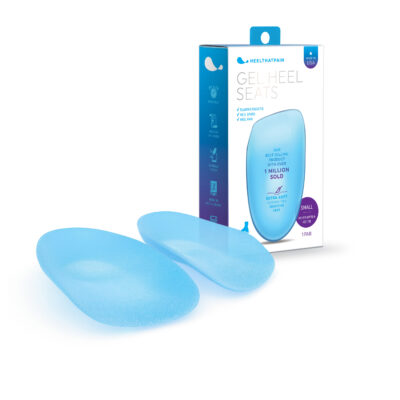Obesity and Heel Pain
In the United States, 38% of adults are considered obese.
And while it’s widely known that obesity increases the risk of cardiovascular disease, arthritis, diabetes, cancer, sleep apnea, hernias, and respiratory problems, many people don’t know that obesity or weight gain also increases the risk of heel pain and Plantar Fasciitis.
Obesity And Heel Pain
While Plantar Fasciitis isn’t necessarily caused by being overweight, several studies have documented the strong correlation between obesity and Plantar Fasciitis. Researchers have also found that heel pain from Plantar Fasciitis is likely to be more severe for individuals who are overweight, with the highest risk of disability and long-term damage.
The arch (plantar fascia), or the thick band of tissue that runs between the ball of the foot and the heel, is primarily responsible for distributing weight and absorbing the impact from daily activities. Carrying extra weight dramatically increases the impact of these daily activities, which can lead to flattening, trauma, micro-injuries, and eventual Plantar Fasciitis in the arch of the foot.
It’s important to understand that healthy or unavoidable weight gain (for example, from pregnancy or the side effects of certain medication) can significantly increase one’s risk of heel pain as well.
Treatments for Heel Pain with Obesity
Heel pain from Plantar Fasciitis can make it extremely difficult to lose weight with exercise, meaning that obesity and heel pain can become a vicious cycle.
And for people with chronic weight issues caused by medications, or rapid weight gain from pregnancy, it may not be realistic or possible to lose weight.
It’s also important to understand that typical remedies for heel pain may be less effective when combined with obesity. For example, rest is often an effective remedy for Plantar Fasciitis. However, for individuals who are overweight or obese, the plantar fascia is more easily injured and often inflamed by even simple activities, like walking around the grocery store.
The following strategies and treatments can be helpful when treating heel pain alongside obesity or rapid weight gain:
Diet Changes and Low-Impact Exercise
Lifestyle changes are one of the best ways to decrease heel pain due to obesity that is not caused by pregnancy or medications. By losing some weight, it’s possible to relieve some of the pressure on the arch of the foot. Diet and low-impact exercise that doesn’t strain or flatten the fascia are two of the most effective strategies:
Low-Impact Exercise
Low-impact exercises avoid running, jumping, and impact to the feet and legs. By incorporating low-impact cardio like water aerobics, swimming, or cycling as well as low-impact strength training like yoga and pilates, you can avoid stressing your injured fascia while strengthening your body and losing weight.
Healthy Diet and Low-Inflammation Foods
Diet is just as important as exercise in losing weight, and it can also play a role in reducing the inflammation in your fascia and promoting healing. Try to add as many healthy inflammation-busting foods to your diet as possible, reduce your calorie intake, limit or eliminate sugar, and make sure your diet is filled with plenty of fiber, fruits and vegetables, protein, and nuts.
Stretching and Strengthening the Feet and Legs
Strengthening your feet, heels, ankles, calves, and legs through stretching will lead to faster healing of your plantar fascia ligament. Daily stretches in all of these areas will improve flexibility, increase blood flow and circulation, help the fascia support weight more effectively, and result in a system that supports and works together much more efficiently.
Support from Orthotic Inserts
Wearing orthotic inserts whenever you’re on your feet is one of the best ways to reduce your pain, stay active, and allow the arch to heal.
Heel Seats sooth the damaged or inflamed arch while lifting it to the right height for bearing weight and absorbing impact properly. These unique orthotics, which can be worn with almost any pair of closed-toe shoes, are effective for more than 90% of people who suffer from heel pain.
Icing and Massage
Icing and massage can provide quick, temporary relief from heel pain on a daily basis. Icing can relief inflammation and numb the body’s pain signals, while massage improves blood flow to the injured arch, breaks up adhesions and scar tissue, and relieves pain through pressure.
Mental and Emotional Support
Remember to be kind to yourself. Managing your weight and healing from Plantar Fasciitis can take time. Finding communities and groups both online and in person to offer emotional support, encouragement, ideas, and understanding can make all the difference in accomplishing your goals.
If you have heel pain, are overweight, or both, you aren’t alone. More than one million people seek help for heel pain each year in the US. Learning how to support your damaged fascia, find relief from your pain, and get the support you need for the unique challenges you’re facing can bring both healing and a new outlook on life.






